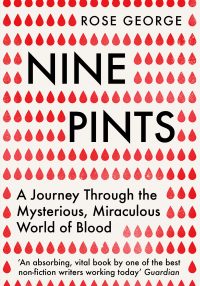
This is an excerpt from Nine Pints by Rose George, which reveals the richness and wonder of the potent red fluid that courses around our bodies, published by Granta Books. Order your copy here.
1
My Pint
There is a TV but I watch my blood. It travels from a needle stuck in the crook of my right elbow, the arm with better veins, into a tube, down into the clear bag that is being hugged by a cradle that rocks then jerks, agitating its contents, stopping the clotting. Rock and wiggle. Rock, then wiggle.
I am giving away almost a pint, and it feels like it always does: soothing and calming. I watch the bag fill with this red rich liquid, which amounts to 13 per cent of my blood supply.1 I am comforted to know that 9 pints – 8, now – of this stuff is moving around my body at any time at two to three miles per hour, taking oxygen to my organs and tissues, removing carbon dioxide, keeping my heart going, keeping me going.2
People have different rates of flow so the machine beeps with alarm when the output is too low. Today mine has been acceptable. Once, my veins were judged too small and I was turned away by the National Health Service Blood and Transplant (NHSBT), and I was insulted as if the rejection were moral, not medical. For a material that has been studied for thousands of years, blood still manages to run from rationality, even at walking pace.
Donating doesn’t take long. I’m done in ten minutes. Female, A pos, time bled 11 a.m. Now I’m due to get thanked. Gratitude is the main theme here: the Wi-Fi password is ‘thank you’. This is the main donor centre in Leeds, my home town and a city of three quarters of a million people. A bright, well-staffed place on one of the biggest shopping streets. Over the road at Red Hot restaurant, you can buy all you can eat from any cuisine in the world, all at once. One hundred dishes. Here, you can lie back and do not much – though clenching your buttocks helps keep your blood moving – and help three people, all at the same time. Give blood, and your donation can be separated by NHSBT, the public health agency that operates blood and organ transplant in England and Wales, into several lifesaving, life-enhancing gifts. By ‘gifts’ they mean components such as red blood cells, platelets, plasma, and other useful fractions. Such details are available in NHSBT literature, as are phrases like ‘date bled’. In the early days of the blood service, there were ‘bleeding couches’. But now the straight-forward language of biology has changed to one of altruism. It’s all ‘donation’ and ‘gift’. The reality of it, that I am emitting a bodily fluid in public, is contained as much as possible, and not just in clear plastic bags.
Once decanted into its container, my blood is on its way to becoming something that even when given for free can be brokered and sold like ingots or wheat. It is also immediately much more perishable than it was in my veins: even when mixed with a storage medium, red blood cells have an official shelf life of between thirty-five and forty-nine days, depending on local laws.3 They last longer than milk but not as long as cheese. This fragile but powerful substance can become a medicine, a lifesaver, and a commodity that is dearer than oil. Yet I give my blood freely because I know that my body will soon replace it and other people need it. I want nothing in return but a mint biscuit, a cup of tea, and a sticker that reads, be nice to me. i gave blood today.
1 A donation of blood in the UK is 470 ml (www.blood.co.uk/the-donation-process/what-happens-on-the-day/). There are precise ways to calculate a person’s blood volume, but the general rule is that blood volume makes up 8 per cent of a person’s body weight. Roughly (www.blood.co.uk/the-donation-process/after-your-donation/how-your-body-replaces-blood/). Also www.hematology.org/Patients/Basics/.
2 I weigh 65 kilograms. Eight per cent of 65 kilograms is 5.2 kilograms. Converting kilograms to pints (though it’s mass to liquid) gets 9.15 pints. Dr Harvey Klein, chief of transfusion medicine at the US National Institutes of Health, backed me up on this. ‘I’ve seen your TED talk. Yes, I’d say about nine pints.’
3 When mixed with additives, red blood cells are allowed to be kept and used for twenty-one days in Japan, thirty-five days in the UK, forty-two days in the United States, Canada, China and many other countries, and between forty-two and forty-nine days in Germany, depending on the additive used. Willy A. Flegel, Charles Natanson and Harvey G. Klein, ‘Does Prolonged Storage of Red Blood Cells Cause Harm?’, British Journal of Haematology 165, no. 1 (2014): 3–16.
Photograph © Joyce Kaes







